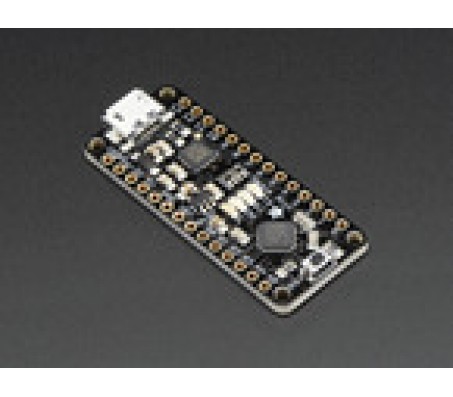Adafruit Metro Mini 328 - 5V 16MHz
Description: We sure love the ATmega328 here at Adafruit, and we use them a lot for our own projects. The processor has plenty of GPIO, Analog inputs, hardware UART SPI and I2C, timers and PWM galore - just enough for most simple projects. When we need to go small, we use a Pro Trinket 3V or 5V, but if you want to have USB-to-Serial built in, we reach for an Adafruit METRO Mini.
METRO Mini is the culmination of years of playing with AVRs: we wanted to make a tiny, breadboard-friendly development board that is easy to use and is hacker friendly. Metro Mini can be programmed with the Arduino IDE (select 'UNO' in the boards dropdown)
- ATmega328 brains - This popular chip has 32KB of flash (1/2 K is reserved for the bootloader), 2KB of RAM, clocked at 16MHz
- Power the METRO Mini with 6-16V polarity protected on the Vin pin, or plug the micro USB connector to any 5V USB source.
- METRO has 20 GPIO pins, 6 of which are Analog in as well, and 2 of which are reserved for the USB-serial converter. There's also 6 PWMs available on 3 timers (1 x 16-bit, 2 x 8-bit). There's a hardware SPI port, hardware I2C port and hardware UART to USB.
- GPIO Logic level is 5V but by cutting and soldering closed a jumper on the bottom, you can easily convert it to 3.3V logic
- 5V onboard regulator with 150mA out, 3.3V 50mA available via FTDI chip
- USB to Serial converter, there's a genuine FTDI hardware USB to Serial converter that can be used by any computer to listen/send data to the METRO, and can also be used to launch and update code via the bootloader
- Four indicator LEDs, on the top of the PCB, for easy debugging. One green power LED, two RX/TX LEDs for the UART, and a red LED connected to pin PB5 / digital #13
- Easy reprogramming, comes pre-loaded with the Optiboot bootloader
- Beautiful styling by PaintYourDragon and Bruce Yan, in Adafruit Black with gold plated pads.
The Metro Mini comes as a fully assembled and tested board, with bootloader burned in and also a stick of 0.1" header. Some light soldering is required if you'd like to plug it into a breadboard, or you can solder wires or header directly to the breakout pads. Once headers are installed they can be fitted into 0.6" wide sockets.
Mac & Windows People! Don't forget to grab & install the FTDI VCP drivers from FTDI to make the COM/Serial port show up right! The default drivers may not support this FTDI chip!
Technical Details:
- Detailed specifications: ATmega328 microcontroller with Optiboot (UNO) Bootloader
- USB Programming and debugging via the well-supported genuine FTDI FT231X
- Input voltage (Vin): 6-16V (a 9VDC power supply is recommended)
- 5V logic with 3.3V compatible inputs, can be converted to 3.3V logic operation
- 20 Digital I/O Pins: 6 are also PWM outputs and 6 are also Analog Inputs
- 32KB Flash Memory - 0.5K for bootloader, 31.5KB available after bootloading
- 16MHz Clock Speed
- Adafruit Black PCB with gold plate on pads
- 18mm x 44mm x 4mm / 0.7" x 1.7" x 0.2"
- Weight: 3g
- Derivative of "Arduino UNO R3 Reference design"
- Open source hardware files on github!
Kirjoita arvostelu
HUOM: HTML-koodia ei käännetä!
Arvio: Huono Hyvä
Kirjoita kuvassa näkyvä varmistuskoodi:









